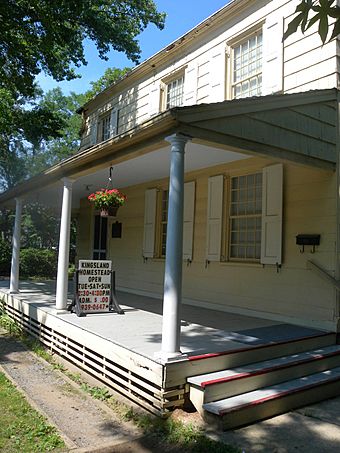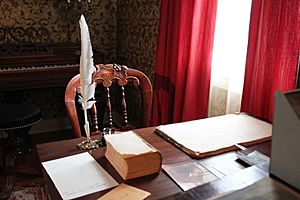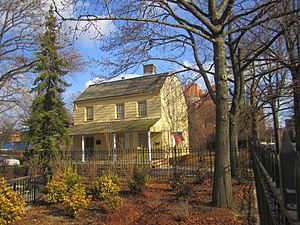Kingsland Homestead facts for kids
|
Kingsland Homestead
|
|
 |
|
| Location | 37th Ave. and Parsons Blvd., New York, New York |
|---|---|
| Area | less than one acre |
| Built | 1774 |
| Architectural style | Colonial |
| NRHP reference No. | 72000905 |
Quick facts for kids Significant dates |
|
| Added to NRHP | May 31, 1972 |
The Kingsland Homestead is a historic house in Flushing, a neighborhood in Queens, New York City. Built in the 1700s, it is a window into the past. The house is famous for being the home of a landmark tree called The Weeping Beech.
Today, the Queens Historical Society runs the homestead, which is open to the public as a museum. It is so important that it's a New York City designated landmark and is listed on the National Register of Historic Places. This means it is protected as a national treasure.
Contents
History of the Homestead
A man named Charles Doughty built the house around 1785. It got the name "Kingsland" from his son-in-law, a British sea captain named Joseph King, who bought the house in 1801.
Saving the House
The Kingsland Homestead has been moved twice to save it from being torn down. In 1923, the city planned to extend the Flushing Line subway, and the house was in the way. It was moved to a new spot to protect it.
Then, in 1965, a new shopping center threatened the house again. The local community worked together to save it. Because of their efforts, the house became one of the first official landmarks in New York City.
In 1968, the house had to be moved one more time to its current location. After a lot of work, it finally opened as a museum in 1973. The house has been carefully restored over the years to keep it in great shape for visitors.
Exhibits at the Museum
The museum shows what life was like during the Victorian era (the late 1800s). It also hosts special exhibits.
Past exhibits have included one about World War II, showing what was happening in Queens during the war. Another exhibit explored the history of slavery in Queens and on Long Island. These exhibits help visitors understand the area's complex past.
The Famous Weeping Beech Tree
Next to the homestead is Weeping Beech Park. For 151 years, this park was home to a huge weeping beech tree. A weeping beech is a type of tree with long, drooping branches that look like they are "weeping."
This special tree was brought from Belgium in 1847. It grew to be 60 feet tall and was so special it was named a living landmark in 1966. It is believed that almost every weeping beech tree in the United States came from this one tree.
Sadly, the tree died in 1997. A special ceremony was held to honor it. Wood from the tree was given to artists, who carved it into sculptures and benches. A large piece of the trunk remains in the park as a memorial. Today, seven new trees grown from the original one stand in the park.
See also






